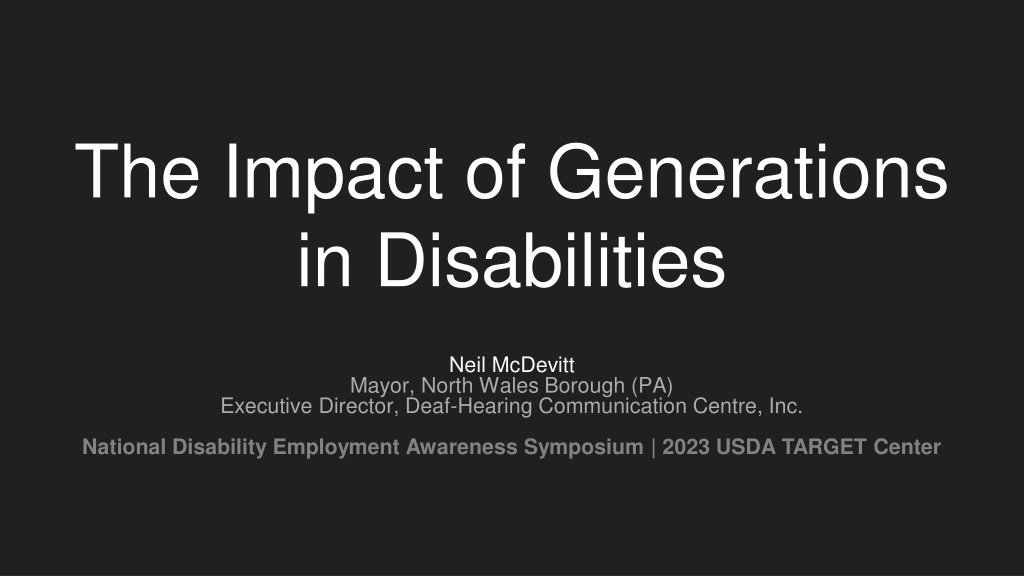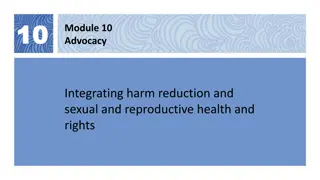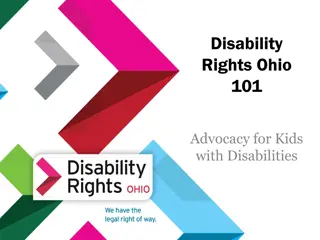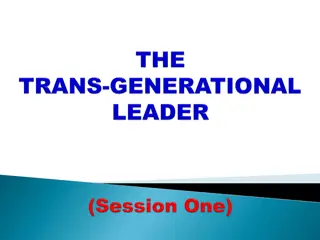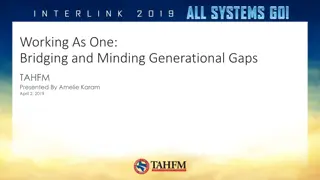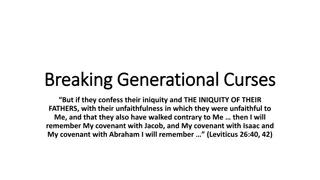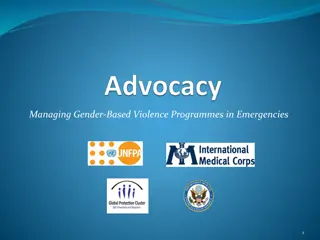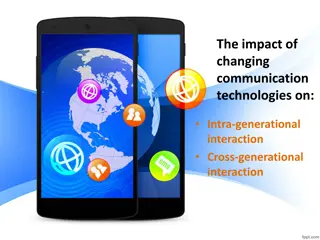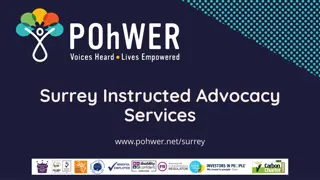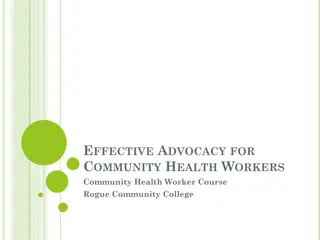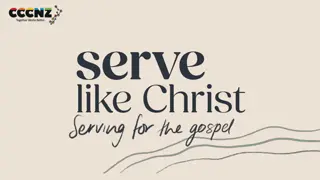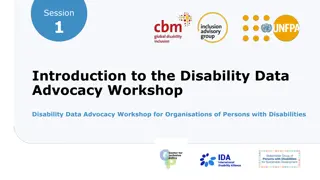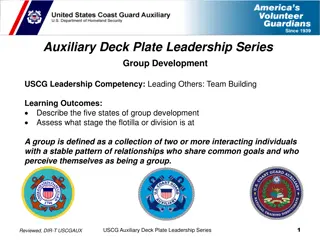Understanding Generational Differences in Disability Advocacy
Explore the impact of generations in disabilities through the lens of the Rehabilitation Act of 1973. Delve into how distinct generational perspectives shape workplace dynamics and advocacy efforts for people with disabilities.
Download Presentation

Please find below an Image/Link to download the presentation.
The content on the website is provided AS IS for your information and personal use only. It may not be sold, licensed, or shared on other websites without obtaining consent from the author. Download presentation by click this link. If you encounter any issues during the download, it is possible that the publisher has removed the file from their server.
E N D
Presentation Transcript
The Impact of Generations in Disabilities Neil McDevitt Mayor, North Wales Borough (PA) Executive Director, Deaf-Hearing Communication Centre, Inc. National Disability Employment Awareness Symposium | 2023 USDA TARGET Center
A little about me Proudly Generation X - born 1973 in North New Jersey. I ve been to most of the places that you see in the opening shots of The Sopranos Before my current positions, I had a chance to work with The Leadership Foundry, an organization of retired military leaders presenting about leadership particularly for Department of Defense Reserve Units. One of the most critical elements of management that they identified was the critical skill of understanding how to manage across generations. After years of working in the field, I saw distinct differences in how different generations of people with disabilities look at advocacy.
This presentation will focus on: Even though the Rehabilitation Act of 1973 is 50 years old this year, it is still a relatively young set of civil rights. There are quite a few people in the workplace who represent distinct generational differences, not just in their age, but also in how the Rehabilitation Act of 1973 affects them. This workshop will explore some of those key distinctions and discuss how they can affect workplace dynamics. Learning Objectives: 1. Highlight the general history of the Rehabilitation Act s passage. 2. Explore the broader demographics of generations as they are commonly understood. 3. Understand how generational differences can often fuel challenges in the workplace. 4. Review the differences in how generations experience the Rehabilitation Act.
What is the Rehabilitation Act? The most influential Civil Rights Act for People with Disabilities to date when it was passed in 1973. In addition to ensuring public service accommodations from anything funded with federal dollars, it also required federal employers to become more welcoming to people with disabilities. It also set the stage for Judy Heumann s Section 504 Sit In in 1977 in San Francisco which was vitally important for the law s regulations to be enacted.
Wait, what IS a generation? Wikipedia defines it as: A generation refers to all of the people born and living at about the same time, regarded collectively. It can also be described as, the average period, generally considered to be about 20 30 years, during which children are born and grow up, become adults, and begin to have children.
Why is this important? Generations will typically have very similar social experiences (that are normal ) that others in the same age group will share. Examples: Rolodex AIM message Picture in a post office A family living in a one bedroom apartment
If you said I know Billy Joel and the song, but not many of the things he s singing about. You re in good company. What did you recognize from that clip? Released in September 1989, its fast-paced lyrics include brief references to 118 significant political, cultural, scientific, and sporting events between 1948 (the year before Billy Joel's birth) and 1989, in mainly chronological order.
Joel conceived the idea for the song when he had just turned 40. He was in a recording studio and met a 21-year-old friend of Sean Lennon who said "It's a terrible time to be 21!". Joel replied: "Yeah, I remember when I was 21 I thought it was an awful time and we had Vietnam, and y'know, drug problems, and civil rights problems and everything seemed to be awful". The friend replied: "Yeah, yeah, yeah, but it's different for you. You were a kid in the fifties and everybody knows that nothing happened in the fifties". Joel retorted: "Wait a minute, didn't you hear of the Korean War or the Suez Canal Crisis?" Joel later said those headlines formed the basic framework for the song. -Wikipedia
How generations tend to treat each other Generally speaking, people in different generations tend to dismiss or discount the experiences of other generations. How many times have you heard someone say, Ok Boomer! or Stupid millennial, go eat a tide pod! These are NOT new! When our baby boomer parents were younger, their elder generations complained about them!
We live in a bizarre time! Thanks to improvements in medical treatment and life expectancy, we live in a time where there are 5 generations in a workplace! Traditionalists: 2% (1925-1945) Baby Boomers: 25% (1946-1964) Generation X: 33% (1965-1980) Generation Y: 35% (1981-2000) Generation Z: 5% (2001-2020) Source: Purdue Global
But Generations are just one layer of a person s identity and personality. So many others, including disability, gender, race, socioeconomic status, LGBTIQA and many more also play a significant role.
Traditionalist (or Greatest) Generation - 1925-1945 Dependable, straightforward, tactful, loyal Shaped by: The Great Depression, World War II, radio and movies Motivated by: Respect, recognition, providing long-term value to the company Communication style: Personal touch, handwritten notes instead of email Worldview: Obedience over individualism; age equals seniority; advancing through the hierarchy Employers should: Provide satisfying work and opportunities to contribute; emphasize stability Source: Purdue Global
Baby Boomers - 1946-1964 Optimistic, competitive, workaholic, team-oriented Shaped by: The Vietnam War, civil rights movement, Watergate Motivated by: Company loyalty, teamwork, duty Communication style: Whatever is most efficient, including phone calls and face to face Worldview: Achievement comes after paying one s dues; sacrifice for success Employers should: Provide them with specific goals and deadlines; put them in mentor roles; offer coaching-style feedback Source: Purdue Global
Generation X - 1965-1980 Flexible, informal, skeptical, independent Shaped by: The AIDS epidemic, the fall of the Berlin Wall, the dot-com boom Motivated by: Diversity, work-life balance, their personal-professional interests rather than the company's interests Communication style: Whatever is most efficient, including phone calls and face to face Worldview: Favoring diversity; quick to move on if their employer fails to meet their needs; resistant to change at work if it affects their personal lives Employers should: Give them immediate feedback; provide flexible work arrangements and work-life balance; extend opportunities for personal development Source: Purdue Global
Millennial Generation - 1981-2000 Competitive, civic-minded, open-minded on diversity, achievement-oriented Shaped by: Columbine, 9/11, the internet Motivated by: Responsibility, the quality of their manager, unique work experiences Communication style: IMs, texts, and email Worldview: Seeking challenge, growth, and development; a fun work life and work-life balance; likely to leave an organization if they don't like change Employers should: Get to know them personally; manage by results; be flexible on their schedule and work assignments; provide immediate feedback Source: Purdue Global
Generation Z - 2001-2020 Global, entrepreneurial, progressive, less focused Shaped by: Life after 9/11, the Great Recession, access to technology from a young age Motivated by: Diversity, personalization, individuality, creativity Communication style: IMs, texts, social media Worldview: Self-identifying as digital device addicts; valuing independence and individuality; preferring to work with millennial managers, innovative coworkers, and new technologies Employers should: Offer opportunities to work on multiple projects at the same time; provide work-life balance; allow them to be self-directed and independent Source: Purdue Global
How many of you saw yourself in your generation s description?
How many of you DIDN T see yourself in your generation s description?
BE HONEST: How many of you reacted negatively to ANOTHER generation s description?
How does this apply in disability community?
Older Generations Younger Generations Person first language became the norm (eg - Americans with Disabilities Act, not Disabled Americans Act) Identify Disability as a culture, not as a condition. Focus has been on increasing access by increasing representation - The Nyle DiMarco / Alli Stroker effect Focused on fighting for the laws and systemic changes that our rights depend upon Individuals have as much effect as team do. They often work in partnership to bring attention to issues. Direct Action by teams of people with disabilities (ADAPT)
What about the Rehab Act? For older people - the Rehabilitation Act came on the heels of a decade-long fight for civil rights for a wide spectrum of people, not just people with disabilities. The Rehabilitation Act was one of the last major civil rights bills during the Second Revolution that lasted from 1964 to 1980. This was done in the backdrop of Black Power, LGBTQIA Rights, Chicano Rights, Native American Rights, and more. For many younger people - they only understood the Americans with Disabilities Act. With the original act and it s updates in 2010 - this has been the common language and they often forget that the Rehabilitation Act is not only older, but can be more powerful.
How do you think these two groups view each other?
How do we move forward? Be aware of your reactions and your biases. We tend to think of younger generations as lazy and older generations as inflexible but these are not true. Figure out ways to bridge those differences. Become a mentor. An older person can help a younger person become more confident in interpersonal conversations. A younger person can help an older person understand a new concept or technology.
Current and Upcoming Meetings OCTOBER MONDAY WEDNESDAY THURSDAY TUESDAY 10/31/2023 10/31/2023 11/2/2023 10/30/2023 11/1/2023 10/19/2023 10/19/2023 11:00AM 12:00PM Identifying Obstacles to Neurodiversity and Inclusion Dr. Theresa Haskins Haskins Consulting 11:00AM 12:00PM Navigating Temporary Disabilities: Resilience and Coping Strategies (Part 2 of 2) Dr. Theresa Haskins Haskins Consulting 11:00AM 12:00PM Postural Ergonomics in the Workplace (Part 2 of 2) Dr. Krista Burns American Posture Institute 11:00 AM 12:00 PM Emotional Intelligence (Part 2 of 2) Carolyn Owens, MCC, SPHR 1:00 pm-2:00 pm 1:00PM 2:00PM Overcoming Barriers to Neurodiversity and Inclusion Dr. Theresa Haskins Haskins Consulting Bridging Gaps: Generations and Disabilities 1:00PM 2:00PM Working Group: MS Teams Is Accessible for All Michelle Sherbondy Education Program Manager Mayor Neil McDevitt
Contact Information TARGET Center Website https://www.usda.gov/target-center TARGET Center Email target-center@usda.gov TARGET Center Phone Number (202) 720-2600
